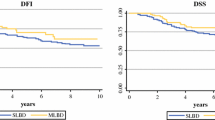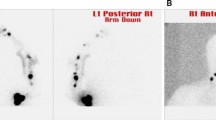Abstract
Background
Patients with cutaneous melanoma (CM) on the trunk have a worse prognosis than those with extremity CM. One reason could be multiple or uncommon (outside axilla or groin) sentinel node locations (SNLs).
Methods
We identified 859 patients who underwent sentinel node biopsy for trunk (n = 465) or extremity (n = 394) CM in three Swedish healthcare regions from 2000 to 2008. We collected patient, tumor, and sentinel node characteristics through clinical registers and medical records. We investigated the distribution of SNLs in a logistic regression model, and risk of overall and melanoma-specific death through 2011 in a multivariable Cox regression model.
Results
Trunk CM was associated with multiple SNLs (31 vs. 7 %; odds ratio [OR] 7.1; 95 % confidence interval [CI] 4.6–11.5; p < 0.001) but not uncommon SNLs (8 vs. 7 %; OR 1.1; 95 % CI 0.6–1.9; p = 0.75) compared with extremity CM. The increased risk of melanoma-specific death was confirmed for trunk CM (hazard ratio [HR] 1.9; 95 % CI 1.3–2.9; p = 0.003), especially on the upper back (HR 2.3; 95 % CI 1.4–3.6; p < 0.001) compared with extremity CM. Uncommon SNLs (HR 0.5; 95 % CI 0.2–1.4; p = 0.21) or multiple SNLs (HR 1.1; 95 % CI 0.4–2.9; p = 0.81) were not associated with melanoma-specific death compared with those with common/single SNL.
Conclusions
Trunk melanomas were associated with multiple lymph drainage, but the worse prognosis of trunk melanomas could not be explained by the increased frequency of multiple or uncommon SNLs.

Similar content being viewed by others
References
Balch CM, Buzaid AC, Soong SJ, et al. Final version of the American Joint Committee on Cancer staging system for cutaneous melanoma. J Clin Oncol. 2001;19(16):3635–3648.
Balch CM, Gershenwald JE, Soong S-J, et al. Final version of 2009 AJCC melanoma staging and classification. J Clin Oncol. 2009;27(36):6199–6206.
National Comprehensive Cancer Network (2013). NCCN guidelines melanoma version 2.2013. http://www.nccn.org/professionals/physician_gls/pdf/melanoma.pdf. Accessed 19 Apr 2013.
Morton DL, Thompson JF, Cochran AJ, et al. Sentinel-node biopsy or nodal observation in melanoma [published erratum appears in N Engl J Med. 2006;355(18):1944]. N Engl J Med. 2006;355(13):1307–1317.
Morton DL. Overview and update of the phase III multicenter selective lymphadenectomy trials (MSLT-I and MSLT-II) in melanoma. Clin Exp Metastasis. 2012;29(7):699–706.
McGregor JM. Too much surgery and too little benefit? Sentinel node biopsy for melanoma as it currently stands. Br J Dermatol. 2013;169(2):233–235.
Uren RF, Howman-Giles R, Thompson JF, et al. Interval nodes: the forgotten sentinel nodes in patients with melanoma. Arch Surg. 2000;135(10):1168–1172.
Thelmo MC, Morita ET, Treseler PA, et al. Micrometastasis to in-transit lymph nodes from extremity and truncal malignant melanoma. Ann Surg Oncol. 2001;8(5):444–448.
Roozendaal GK, de Vries JD, van Poll D, et al. Sentinel nodes outside lymph node basins in patients with melanoma. Br J Surg. 2001;88(2):305–308.
Vidal-Sicart S, Pons F, Fuertes S, et al. Is the identification of in-transit sentinel lymph nodes in malignant melanoma patients really necessary? Eur J Nucl Med Mol Imaging. 2004;31(7):945–949.
McMasters KM, Chao C, Wong SL, et al. Interval sentinel lymph nodes in melanoma. Arch Surg. 2002;137(5):543–547;discussion 547–549.
Sumner WE 3rd, Ross MI, Mansfield PF, et al. Implications of lymphatic drainage to unusual sentinel lymph node sites in patients with primary cutaneous melanoma. Cancer. 2002;95(2):354–360.
Verwer N, Scolyer RA, Uren RF, et al. Treatment and prognostic significance of positive interval sentinel nodes in patients with primary cutaneous melanoma. Ann Surg Oncol. 2011;18(12):3292–3299.
Chakera AH, Hansen LB, Lock-Andersen J, et al. In-transit sentinel nodes must be found: implication from a 10-year follow-up study in melanoma. Melanoma Res. 2008;18(5):359–364.
Soteldo J, Ratto EL, Gandini S, et al. Pelvic sentinel lymph node biopsy in melanoma patients: is it worthwhile? Melanoma Res. 2010;20(2):133–137.
Karakousis GC, Pandit-Taskar N, Hsu M, et al. Prognostic significance of drainage to pelvic nodes at sentinel lymph node mapping in patients with extremity melanoma. Melanoma Res. 2013;23(1):40–46.
Steen ST, Kargozaran H, Moran CJ, et al. Management of popliteal sentinel nodes in melanoma. J Am Coll Surg. 2011;213(1):180–186;discussion 186–187.
Porter GA, Ross MI, Berman RS, et al. Significance of multiple nodal basin drainage in truncal melanoma patients undergoing sentinel lymph node biopsy. Ann Surg Oncol. 2000;7(4):256–261.
Jacobs IA, Chang CK, Salti GI. Significance of dual-basin drainage in patients with truncal melanoma undergoing sentinel lymph node biopsy. J Am Acad Dermatol. 2003;49(4):615–619.
Jimenez RE, Panageas K, Busam KJ, Brady MS. Prognostic implications of multiple lymphatic basin drainage in patients with truncal melanoma. J Clin Oncol. 2005;23(3):518–524.
McHugh JB, Su L, Griffith KA, et al. Significance of multiple lymphatic basin drainage in truncal melanoma patients undergoing sentinel lymph node biopsy. Ann Surg Oncol. 2006;13(9):1216–1223.
Federico AC, Chagpar AB, Ross MI, et al. Effect of multiple-nodal basin drainage on cutaneous melanoma. Arch Surg. 2008;143(7):632–637;discussion 637–638.
Piñero A, de Torre C, Martínez-Escribano J, et al. Multiple lymphatic basin drainage from cutaneous melanoma as a prognostic factor. World J Surg. 2012;36(3):579–585.
Ribero S, Quaglino P, Osella-Abate S, et al. Relevance of multiple basin drainage and primary histologic regression in prognosis of trunk melanoma patients with negative sentinel lymph nodes. J Eur Acad Dermatol Venereol. 2013;27(9):1132–1137.
Thompson JF, Uren RF, Shaw HM, et al. Location of sentinel lymph nodes in patients with cutaneous melanoma: new insights into lymphatic anatomy. J Am Coll Surg. 1999;189(2):195–204.
Uren RF, Howman-Giles R, Thompson JF. Patterns of lymphatic drainage from the skin in patients with melanoma. J Nucl Med. 2003;44(4):570–582.
Marone U, Aloj L, Di Monta G, Caracò C. Lymphoscintigraphy defines new lymphatic pathways from cutaneous melanoma site: clinical implications and surgical management. Radiol Res Pract. 2011;2011:817043.
Lieber KA, Standiford SB, Kuvshinoff BW, Ota DM. Surgical management of aberrant sentinel lymph node drainage in cutaneous melanoma. Surgery. 1998;124(4):757–761;discussion 761–762.
Uren RF, Howman-Giles R, Thompson JF. Lymphatic drainage from the skin of the back to retroperitoneal and paravertebral lymph nodes in melanoma patients. Ann Surg Oncol. 1998;5(4):384–387.
Uren RF. Lymphatic drainage of the skin. Ann Surg Oncol. 2004;11(3):179–185S.
Callender GG, Egger ME, Burton AL et al. Prognostic implications of anatomic location of primary cutaneous melanoma of 1 mm or thicker. Am J Surg. 2011;202(6):659–664;discussion 664–665.
Gillgren P, Drzewiecki KT, Niin M, et al. 2-cm versus 4-cm surgical excision margins for primary cutaneous melanoma thicker than 2 mm: a randomised, multicentre trial. Lancet. 2011;378(9803):1635–1642.
Balch CM, Soong SJ, Gershenwald JE, et al. Prognostic factors analysis of 17,600 melanoma patients: validation of the american joint committee on cancer melanoma staging system. J Clin Oncol. 2001;19(16):3622–34.
Gillgren P, Brattstrom G, Frisell J, et al. Effect of primary site on prognosis in patients with cutaneous malignant melanoma: a study using a new model to analyze anatomical locations. Melanoma Res. 2005;15(2):125–32.
Statistics Sweden. Population by region, marital status, age and sex: year 1968–2012. http://www.scb.se/Page/SSD/SSD_SelectVariables____340507.aspx?px_tableid=ssd_extern%3aBefolkningNy&rxid=8e02bc52-52d4-49e1-acfe-2243b7922f53. Accessed 27 Apr 2013.
Gershenwald JE, Ross MI. Sentinel-lymph-node biopsy for cutaneous melanoma. N Engl J Med. 2011;364(18):1738–1745.
Breslow A. Thickness, cross-sectional areas and depth of invasion in the prognosis of cutaneous melanoma. Ann Surg. 1970;172(5):902–908.
Clark WH Jr, From L, Bernardino EA, Mihm MC. The histogenesis and biologic behavior of primary human malignant melanomas of the skin. Cancer Res. 1969;29(3):705–727.
National Healthcare Quality Registries in Sweden. http://www.kvalitetsregister.se/om_kvalitetsregister/quality_registries. Accessed 9 May 2013.
Gillgren P, Brattstrom G, Djureen Martensson E, et al. A new computerized methodology to analyse tumour site in relation to phenotypic traits and epidemiological characteristics of cutaneous malignant melanoma. Br J Dermatol. 2002;146(6):1023–1030.
Uren RF, Howman-Giles R, Thompson JF, et al. Lymphatic drainage to triangular intermuscular space lymph nodes in melanoma on the back. J Nucl Med. 1996;37(6):964–966.
Lai DT, Thompson JF, Quinn MJ, et al. New route for metastatic spread of melanoma? Lancet. 1993;341(8840):302.
The National Board of Health and Welfare. Cause-of-death registry. Stockholm: official statistics of Sweden. http://www.socialstyrelsen.se/register/dodsorsaksregistret. Accessed 13 May 2013.
Statistics Sweden. Background facts on population and welfare Statistics. Historic population register. http://www.scb.se/statistik/_publikationer/BE9999_2006A01_BR_BE96ST0603.pdf. Accessed 16 May 2013.
Day CL Jr, Mihm MC Jr, Sober AJ, et al. Prognostic factors for melanoma patients with lesions 0.76–1.69 mm in thickness. An appraisal of “thin” level IV lesions. Ann Surg. 1982;195(1):30–34.
Woods JE, Taylor WF, Pritchard DJ, et al. Is the BANS concept for malignant melanoma valid? Am J Surg. 1985;150(4):452–455.
Rogers GS, Kopf AW, Rigel DS et al. Influence of anatomic location on prognosis of malignant melanoma: attempt to verify the BANS model. J Am Acad Dermatol. 1986;15(2 Pt 1):231–237.
Cascinelli N, Vaglini M, Bufalino R, Morabito A. BANS. A cutaneous region with no prognostic significance in patients with melanoma. Cancer. 1986;57(3):441–444.
Acknowledgment
We are grateful to Assistant Professor Jan Mattson at Sahlgrenska University Hospital, Gothenburg for aid in the collection of data.
Conflict of interest
No conflicts of interest declared. Daniela Gordon is currently receiving a grant from the regional agreement on medical training and clinical research (ALF) between Stockholm County Council and Karolinska Institutet. Karin E. Smedby holds a grant from the Strategic Research Program in Epidemiology.
Author information
Authors and Affiliations
Corresponding author
Electronic supplementary material
Below is the link to the electronic supplementary material.
10434_2014_3744_MOESM2_ESM.tiff
Supplement 2. Anatomic model (SkinTrac©) with primary site of cutaneous melanoma (CM) by multiple (top) and single (bottom) sentinel node location (SNL). (TIFF 655 kb)
Rights and permissions
About this article
Cite this article
Gordon, D., Smedby, K.E., Schultz, I. et al. Sentinel Node Location in Trunk and Extremity Melanomas: Uncommon or Multiple Lymph Drainage Does Not Affect Survival. Ann Surg Oncol 21, 3386–3394 (2014). https://doi.org/10.1245/s10434-014-3744-0
Received:
Published:
Issue Date:
DOI: https://doi.org/10.1245/s10434-014-3744-0




